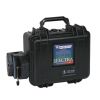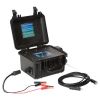Proactive 60 Amp Mobile Battery Pack
Features
- Easy to read display shows remaining battery voltage
- Incorporates 60 Amp AGM non-spillable battery
- USB plug output for charging cell phone
- Expedited repair and warranty service
- Lifetime technical support
- More
The Proactive 60 Amp Mobile Battery Pack is a compact, durable and portable 12 volt DC system specifically designed for most of Proactive’s 12 volt DC pumps. This self-contained, rechargeable 12-volt system can very easily replace gas generators or automotive batteries.
The 60 Amp Mobile Battery Pack is great for groundwater and surface water sampling applications that require "no spark" at the power source. The 60 Amp Mobile Battery Pack is as easy as 1..2..3... First, The field technician confirms that the "master power switch" is turned to the "off" position. Second, the field technician hooks up the Proactive 12 volt DC pump to the 60 Amp Mobile Battery Pack; Positive connection first to the 60 Amp Mobile Battery Pack and then negative connection from the pump to the negative terminal on the 60 Amp Mobile Battery Pack. Thirdly, the field technician turns the "master power switch" to the "on" position, energizing the 60 Amp Mobile Battery Pack. By following this exact sequence of events will "practically eliminate" a spark from the Proactive 60 Amp Mobile Battery Pack.
- Internal Battery Charger: 8 Amp
- Measurements: 16.5" width x 8.5" depth x 13.5" height
- Weight: 50 lbs.
In The News
Expanding the Port Everglades: Real-Time Monitoring of Water Quality Conditions from Planned Dredging Operation
The Port Everglades in Broward County, Florida, serves large trade vessels and cruiseliners and incoming and outgoing recreational boaters. However, as cargo ships become larger, the port must expand. A dredging project led by the US Army Corps of Engineers will substantially deepen and widen the port's navigation channel to accommodate larger Panamax cargo ships and modern cruise liners. As a result of this project, a large amount of sediment will be displaced into the water column. This suspended sediment may settle outside of the project area, burying benthic organisms like corals, and possibly carrying harmful particulates to other regions. [caption id="attachment_39497" align="aligncenter" width="2560"] A CB-950 and CB-25 deployed on site at Port Everglades.
Read MoreIt’s Time to React to Water Quality: Proteus Multiparameter Probe aboard NexSens Buoy
Water quality monitoring is essential for safeguarding public health, protecting ecosystems, and ensuring the sustainability of water resources. Contaminants such as industrial pollutants, agricultural runoff, and sewage discharge can severely impact aquatic life and pose serious risks to human health if left unchecked. Traditionally, water quality monitoring has been a slow and labor-intensive process, requiring samples to be collected, transported to a lab, and analyzed—a process that can take days. However, with the advancement of real-time sensor technology, environmental agencies, researchers, and industries can now monitor water quality instantly.
Read MoreSafeguarding Communities with Real-Time Flood Monitoring in the City of Hazelwood
The City of Hazelwood is a suburb in St. Louis County, Missouri, home to around 25,500 people. Recently, the community has suffered increased flash flooding following severe storms, prompting the need for the installation of a flood monitoring system. In 2022, a NexSens X2 data logger was installed to monitor water level and rainfall in real-time, with the aim of reducing the loss of life and property as a result of extreme weather events. [caption id="attachment_39411" align="alignnone" width="940"] The latest flood event at Coldwater Creek, where the water level rose by 14 feet, exceeding the height of the X2 by three feet. The sensor can be seen behind the wall that usually contains the Creek.
Read More









